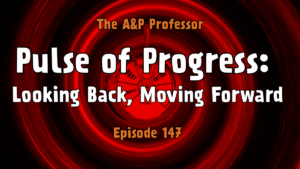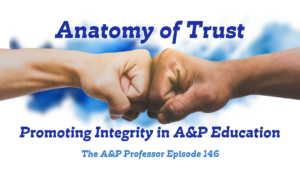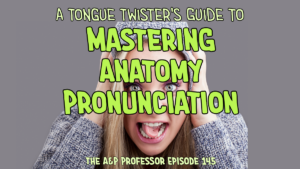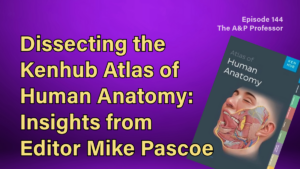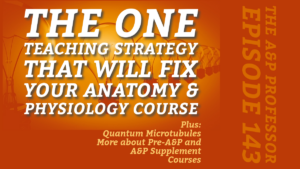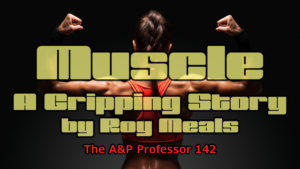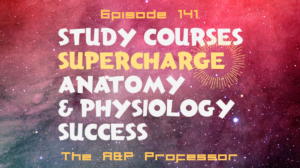In Episode 147, host Kevin Patton reviews the highlights and events of the previous year in the world of The A&P Professor. He then turns to last year's predictions for teaching human anatomy and physiology to see if he was on the right track. Finally, predictions for the coming year are revealed. And lots of other stuff—this episode is two hours long, after all!
0:00:00 | Introduction
0:00:50 | Debrief: Topics, Stats, Reflections
0:21:28 | A Long, Long, Long Episode
0:23:05 | Debrief: More Reviewing & Reflecting
0:38:59 | Did I Get My Predictions Right?
0:50:22 | Textbook & Academic Authors Association
0:57:47 | Looking Ahead with New (Old) Predictions
1:10:49 | Brain Break
1:12:58 | A Couple More Predictions
1:24:50 | What's on TAPP?
1:26:20 | More New Predictions
1:44:47 | Let's Share
1:45:41 | Even More New Predictions
1:58:20 | Staying Connected
★ If you cannot see or activate the audio player, go to: theAPprofessor.org/podcast-episode-147.html
🏅 Apply for your credential (badge/certificate) for listening to this episode: theAPprofessor.org/podcast-episode-147.html/#badge
⭐⭐⭐⭐ Please rate & review this podcast so that others can decide whether to give it a try: RateThisPodcast.com/theAPprofessor
❓ Please take the anonymous survey: theAPprofessor.org/survey
☝️ Questions & Feedback: 1-833-LION-DEN (1-833-546-6336)
✔️ Follow The A&P Professor on Twitter, Facebook, Blogger, Substack, Tumblr, or Instagram! @theAPprofessor
📰 Get the once-or-twice-weekly TAPP Science & Education Updates theAPprofessor.org/updates
Reflection is an essential part of learning. Debriefing after any experience is key to personal and professional growth. (Sharon Salzberg))
Debrief: Topics, Stats, Reflections
20.5 minutes
This segment begins our debriefing process by reflecting on the audience size (which a nearly impossible to measure), and quickly reviewing who we talked to and what we talked about over the last season. It turns out that many important and useful topics came up this season, including two episodes that sort of summarize all I've learned about teaching A&P over my decades-long career. And then there's that one weird episode that I snuck in at the beginning of the year, as the entry of AI into teaching and learning was suddenly on everyone's mind—when I'd intended to be doing last year's debriefing instead .
★ Podcast List (searchable list of all episodes of this podcast, including titles, topics, and links to each episode page) theAPprofessor.org/podlist
Please rate & review The A&P Professor—it helps others decide whether to give us a try! 😁
★ RateThisPodcast.com/theAPprofessor
A Long, Long, Long Episode
1.5 minutes
A brief "brain break" to talk about the fact that this episode is particularly long—and why. And how to manage listening to long podcast episodes.
★ Using chapters on Apple Podcasts (explains how to navigate segments [chapters] on Apple Podcasts; generally applies to any podcast player) AandP.info/5kp
Debrief: More Reviewing & Reflecting
13 minutes
Here, we talk about the value of feedback from listeners, particularly through the new and improved listener survey.
★ TAPP Listener Survey (a new and improved way to give feedback) theAPprofessor.org/survey
★ Want to be part of TAPP by being a guest? Go to theAPprofessor.org/bemypodcastguest and pick a convenient day and time. It's fun. Really.
★ Want to be a guest host or an occasional correspondent to the TAPP podcast? Think about it. It would be a blast, right? Contact me anytime to chat about it. Even if you don't know what you want to do, we can brainstorm together.
★ Temper Your Harsh Critic By Looking For A Podcast's Best Trick (this is a brief episode in which I was the guest host; it's aimed at podcasters, but the lesson I teach applies to teaching, too) AandP.info/nm5
★ The TAPPapp (a free app to listen to episodes of this podcast—and get bonus content such as PDF transcripts) search for it in your device's app store or go to theAPprofessor.org/TAPPapp
★ Check out the new graphics on the home page https://theAPprofessor.org and on the podcast landing page theAPprofessor.org/podcast
★ New social channels for The A&P Professor
★ ★ Threads threads.net/@theapprofessor
★ ★ Mastodon qoto.org/@theAPprofessor
★ ★ Bluesky bsky.app/profile/theapprofessor.org
★ ★ Reddit reddit.com/r/theAPprofessor/
★ ★ TikTok tiktok.com/@theapprofessor
★ ★ Substack theAPprofessor.substack.com/
★ The A&P Professor Science & Education Updates (free headlines and snippets of news stories of interest to A&P faculty) theAPprofessor.org/updates
Did I Get My Predictions Right?
16 minutes
In this segment, we briefly review the predictions made for 2023 to see if we got close on any of them.
★Review a Year. Preview a Year. | Debriefing & Predictions | TAPP 132
★ Chatbot responses suggest that hypothetical biology questions are harder than realistic ones (the Crowther, et al. paper that I mentioned participating in) AandP.info/3rv
★ Test Question Templates Help Students Learn | TAPP 70
★ Micro-Credentials & Gamification in the A&P Course | Brown & Black Skin | Refresher Tests | TAPP 87
★ A Pre-A&P Course Improves Student Success in Anatomy & Physiology | TAPP 140 (discusses how I use badges in a course)
★ DEI Is Under Attack At Colleges And Universities (article from Forbes) AandP.info/8jr
★ The Chronicle of Higher Education Releases Updated DEI Legislation Tracker (press release describing monitoring 49 bills in 23 states) AandP.info/2x8
★ Walking Faculty Back from the Cliff (article from Inside Higher Ed) AandP.info/raw
★ A Look Back at College Closures and Merger (article from Inside Higher Ed) AandP.info/hdp
Textbook & Academic Authors Association
7.5 minutes
We take a brief pause to talk about the Textbook & Academic Authors Association (TAA) in which many A&P professors find helpful support and benefits. With a strongly supportive network of colleagues, TAA provides many resources and active, engaging opportunities for growth and network-forming. TAA meets the needs of those interested in creating textbooks, lab manuals, workbooks, and other learning resources, as well as those who focus on academic writing, such as journal articles, dissertations/theses, monographs, and scholarly or other nonfiction works.
Kevin explains a special deal to get started with TAA: To join for only $30, select a membership category at the TAA website and then, when you check out, use coupon code TAA20 if you're a graduate student, or TAA70 if you are a published or aspiring textbook or academic author or industry professional.
★ TAA website (explore to find the kinds of things that will help you grow in your academic writing adventures) taaonline.net/
Looking Ahead with New (Old) Predictions
13 minutes
The first four predictions (#1 through #4) for 2024 focus on AR, VR, AI, overreliance on technology, a widening digital divide, and decreasing lecture engagement and attendance.
★ Higher Education Solutions (from Verizon, but has many links to resources on using AR and VR in teaching and learning) AandP.info/c2g
★ Future Prospects and Considerations for AR and VR in Higher Education Academic Technology (article from Educause Review) AandP.info/u5e
★ The science events to watch for in 2024 (article from Nature that talks about advanced AI tools and other developments) AandP.info/9sy
★ Will AI replace the educator? (brief article gets to the heart of the matter) AandP.info/l0y
★ Is AI the Beginning or End of Learning? | TAPP 131
★ Dancing Organelles, AI Resources, Distracting Animations, Timed Tests & Micro-credentials | TAPP 138
★ The Human Microbial System | Episode 47 (includes the controversial segment Teachers vs. Robots)
★ 49 Tricks for Retention & Success in Online Courses | Episode 21
★ 49 MORE Tricks for Retention & Success in Online Courses | Episode 22
★ EVEN MORE Tricks for Retention & Success in Online Courses | Episode 23
★ State of Student Success and Engagement in Higher Education (recent report from Instructure) AandP.info/ir9
★ Clickers
Brain Break
2 minutes
Kevin explains why he tries to break up long lectures. This is a long podcast, so it calls for such breaks.
★ Breaking Up a Lecture (brief explanation by Dirk Mateer) AandP.info/gc4
★ Lecture Breaks to Re-engage Students (brief video from McGill Science explains many different reasons why a brain break in a lecture is a good idea) AandP.info/jqr
★ Which Is Better, Active Learning or Lecture? It’s Not So Simple.(in case you are thinking that we don't need a break because we shouldn't be lecturing) AandP.info/n20
★ Playful & Serious Is the Perfect Combo for A&P | Episode 13
★ Krebs Cycle Horror Story | Anatomy Terms | TAPP 79 (includes example of a playful activity to better understand ATP phosphorylation)
A Couple More Predictions
12 minutes
Our next two predictions (#5 and #6) for 2024 involve expanding online/hybrid courses (really) and accompanying changes in textbooks and other learning resources. What do you think?
★ The Death of the Physical Textbook? 3 Accelerating Trends in #Edtech (article from BibliU) AandP.info/g1w
★ The Surprising Power of Digital Textbooks | TAPP 76
★ Just-In-Time Teaching | JiTT (resource about this technique from Vanderbilt University's Center for Teaching) AandP.info/pco
★ Lecture Previews | Using Narrated Presentations to Prepare Students for Class (my seminar that explains how I've adapted just-in-time teaching to my own A&P courses)
What's on TAPP?
1.5 minutes
TAPP is the abbreviation of The A&P Professor. Where you are right now. A quick break to remind us of what's available online for this (or any) episode...and beyond!
★ Pulse of Progress: Looking Back, Moving Forward | TAPP 147 (the episode page for this episode)
★ Episode List (all the episodes, with main topics)
★ Education | Professional Development (the TAPP credentials page, with links to all the badges/certificates available)
★ Seminars (all the TAPP seminars, each available on-demand)
More New Predictions
18.5 minutes
In this segment, Kevin gives predictions #7, #8, and #9 regarding the ups and downs of taking an interdisciplinary approach to teaching and learning anatomy and physiology, micro-credentials and competency-based approaches, and the ups and downs of diversity, equity, and inclusion over the coming year. And we hear again from Mike Pascoe and Jerry Anzalone.
★ How Multidisciplinary Approach Can Shape The Future Of Innovation And Education (article from Forbes) AandP.info/j14
★ What is Competency-Based Education? (from the American Association of Colleges of Nursing) AandP.info/brg
★ What Competency-Based Education Means for Colleges (article from US News & World Report) AandP.info/4nn
★ Education | Professional Development (the TAPP credentials page, with links to all the badges/certificates available)
★ The One Teaching Strategy That Will Fix Your Anatomy & Physiology Course | TAPP 143 (includes my infamous rant about uniformity in A&P courses)
★ The Uncertainty Effect with Michelle Lazarus | TAPP 135
★ DEI Is Under Attack At Colleges And Universities (article from Forbes) AandP.info/8jr
★ The Chronicle of Higher Education Releases Updated DEI Legislation Tracker (press release describing monitoring 49 bills in 23 states) AandP.info/2x8
★ Deep Elaboration & Other Stories of Teaching Anatomy & Physiology | TAPP 136
★ Dissecting the Kenhub Atlas: Insights from Editor Mike Pascoe | TAPP 144
★ The Inclusive Anatomy & Physiology Course | Part 1 | TAPP 108
★ The Inclusive Anatomy & Physiology Course | Part 2 | 8 More Tips to Include All | TAPP 109
★ When You Come to a Fork in the Road, Take It!: Inspiration and Wisdom from One of Baseball's Greatest Heroes (book by Yogi Berra) geni.us/AzcxHl
Let's Share
1 minute
This short break reminds us to share The A&P Professor experience with others.
★ Discover the TAPPapp
★ theAPprofessor.org/refer (share link)
★ theAPprofessor.org/podcast
★ theAPprofessor.org/listen
Even More New Predictions
12.5 minutes
Kevin's last three predictions (#10, #11, and #12) focus on faculty life (including input from Jerry Anzalone), science communication, and the evolution of how we position fibers in the story of the human body.
★ The Impact of The Gig Economy on Higher Education Marketing (article posted in LinkedIn) AandP.info/mpv
★ ‘The Gig Academy’ (review of a book about academic deprofessionalization and adjunctification) AandP.info/3u9
★ Walking Faculty Back from the Cliff (article from Inside Higher Ed) AandP.info/raw
★ Burnout! A Chat with Rebecca Pope-Ruark | TAPP 91
★ Cell Architecture (recent issue of Current Opinion in Cell Biology has many articles on the roles of fibers in the boy that underscore my prediction at the end of this segment) AandP.info/fvt
People
Production: Aileen Park (announcer), Andrés Rodriguez (theme composer, recording artist), Karen Turner (Executive Editor), Kevin Patton (writer, editor, producer, host).
Not People
Robotic (AI) audio leveling/processing and transcription is done by Auphonic.com and the content, spelling, grammar, style, etc., of these episode notes are assisted by various bots, such as ChatGPT, Grammarly, and QuillBot.
Click here to listen to this episode—or access the detailed notes and transcript.

